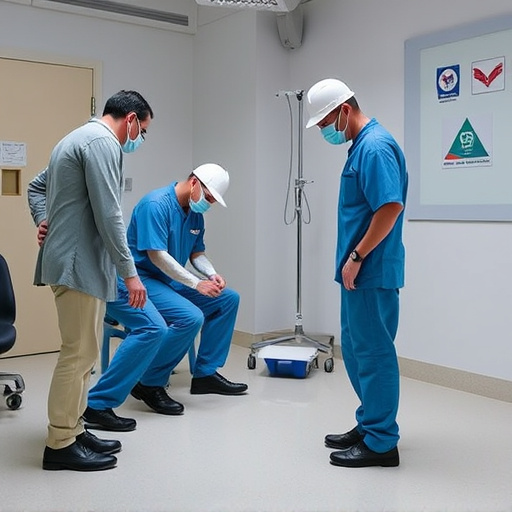Early intervention is key in managing muscle, tendon, and ligament injuries common in the workplace, leading to efficient workers compensation injury care. This involves immediate RICE (Rest, Ice, Compression, Elevation) methods, followed by specialized treatments like physical therapy. A holistic approach combining medication, alternative therapies, and preventative measures accelerates recovery, reduces long-term disability risks, and facilitates a swift return to work, ultimately minimizing workers' comp claims.
Muscle, tendon, and ligament (MTL) injuries are common in the workplace, often leading to significant workers’ compensation claims. This comprehensive guide explores effective treatment strategies for these injuries. From understanding the mechanics behind MTL damage to implementing early intervention techniques, we delve into essential care methods like RICE therapy and the role of physical therapy. Additionally, we examine medications, alternative treatments, and preventative measures to help reduce recurrence in high-risk environments.
- Understanding Muscle, Tendon, and Ligament Injuries: A Common Worker's Compensation Concern
- Early Intervention: Key Strategies for Effective Treatment
- Rest, Ice, Compression, and Elevation (RICE): A Fundamental Approach
- Physical Therapy: Targeted Exercises for Healing and Strengthening
- Medications and Alternative Treatments: Exploring Options
- Preventative Measures: Eradicating Recurrence in the Workplace
Understanding Muscle, Tendon, and Ligament Injuries: A Common Worker's Compensation Concern

Muscle, tendon, and ligament injuries are prevalent in the workplace, often leading to workers’ compensation claims. These types of injuries, commonly referred to as soft tissue injuries, can result from various activities, including repetitive motions, sudden twists, or direct impacts. Understanding these injuries is essential for both employees and employers to ensure proper care and management.
Workers compensation injury care plays a crucial role in supporting individuals who sustain these injuries. Early intervention, including rest, ice, compression, and elevation (RICE), can help reduce pain and inflammation. Additionally, physical therapy and specialized treatments like massage, ultrasound, or steroid injections may be recommended to promote healing and restore function. Effective management not only aids in the patient’s recovery but also minimizes the potential for long-term disability and ensures employees can return to their jobs safely.
Early Intervention: Key Strategies for Effective Treatment

Early intervention plays a pivotal role in the effective treatment of muscle, tendon, and ligament injuries, especially in the context of workers’ compensation claims. The moment an injury occurs, whether due to sudden trauma or overuse, prompt action can significantly impact the long-term recovery process. One key strategy is to initiate specialized care immediately; this often involves a multi-faceted approach tailored to the specific injury type. Physiotherapy and occupational therapy are essential components, focusing on exercises to improve strength, flexibility, and range of motion while also addressing any functional deficits.
Additionally, early intervention may include ice or heat therapy, compression, and elevation (RICE method) to manage pain and swelling, as well as prescription medications or corticosteroid injections for more severe cases. The goal is to reduce inflammation, prevent scar tissue formation, and preserve joint function. This proactive treatment not only speeds up recovery but also helps workers return to their duties sooner, potentially reducing the financial burden associated with extended absence due to a work-related injury.
Rest, Ice, Compression, and Elevation (RICE): A Fundamental Approach

Rest, Ice, Compression, and Elevation (RICE) is a fundamental approach to managing muscles, tendons, and ligaments injuries, often integral in workers compensation care. This method provides an effective, conservative treatment strategy for acute injuries. The initial focus on rest helps prevent further damage by ceasing all activities that might aggravate the condition.
Ice therapy plays a crucial role in reducing pain, swelling, and inflammation. Applying ice packs can help constrict blood vessels, limiting blood flow to the affected area and minimizing swelling. Compression further aids in controlling swelling by applying gentle yet firm pressure, while elevation helps drain excess fluid from the injured site, promoting faster healing. This simple yet powerful combination is often a worker’s best ally in managing workplace injuries covered under compensation care plans.
Physical Therapy: Targeted Exercises for Healing and Strengthening

Physical therapy plays a crucial role in the rehabilitation process for muscles, tendons, and ligaments, especially in cases of work-related injuries covered by workers’ compensation. Targeted exercises tailored to the specific injury are a key component. These exercises focus on improving range of motion, restoring strength, and enhancing flexibility. Physical therapists design personalized programs that consider the type and severity of the injury, ensuring gradual progression to avoid further damage.
For workers compensation injury care, physical therapy offers a holistic approach. Exercises may include stretching, strengthening maneuvers, and functional training activities. The goal is not only to heal but also to prevent future injuries by improving overall body mechanics and endurance. This tailored care contributes significantly to an individual’s ability to return to their regular routine or job duties with enhanced resilience and reduced risk of re-injury.
Medications and Alternative Treatments: Exploring Options

When it comes to treating muscles, tendons, and ligaments, especially in cases involving worker’s compensation injuries, a multifaceted approach is often necessary. Medications play a significant role in managing pain and reducing inflammation. Over-the-counter anti-inflammatory drugs like ibuprofen or naproxen can help alleviate discomfort associated with these injuries. For more severe cases, prescription medications such as corticosteroids may be recommended by healthcare professionals to provide targeted relief.
Beyond traditional medications, alternative treatments have gained popularity for their potential benefits in worker’s compensation injury care. These include physical therapy, which focuses on strengthening exercises and stretching routines tailored to specific areas of discomfort or injury. Other options like acupuncture and chiropractic care are also worth exploring, as they can offer natural ways to manage pain and promote healing. Additionally, massage therapy has been shown to improve circulation, reduce muscle tension, and enhance overall recovery.
Preventative Measures: Eradicating Recurrence in the Workplace

Preventative Measures play a pivotal role in eradicating recurrence, especially in workplace settings where musculoskeletal injuries can lead to significant time off and workers’ compensation claims. Employers and employees alike should adopt strategies that focus on ergonomic design, proper lifting techniques, and regular employee training. Investing in ergonomically designed workstations and equipment reduces physical strain, minimizing the risk of tendonitis, ligament sprains, and muscle strains.
Additionally, implementing safe lifting practices and providing resources for injury prevention can significantly cut down on workplace injuries. Regular training sessions should educate workers about the proper techniques for lifting heavy objects, using appropriate tools, and recognizing early signs of musculoskeletal distress. Such proactive measures not only contribute to a healthier workforce but also help in avoiding costly workers’ compensation care and potential long-term disabilities.














